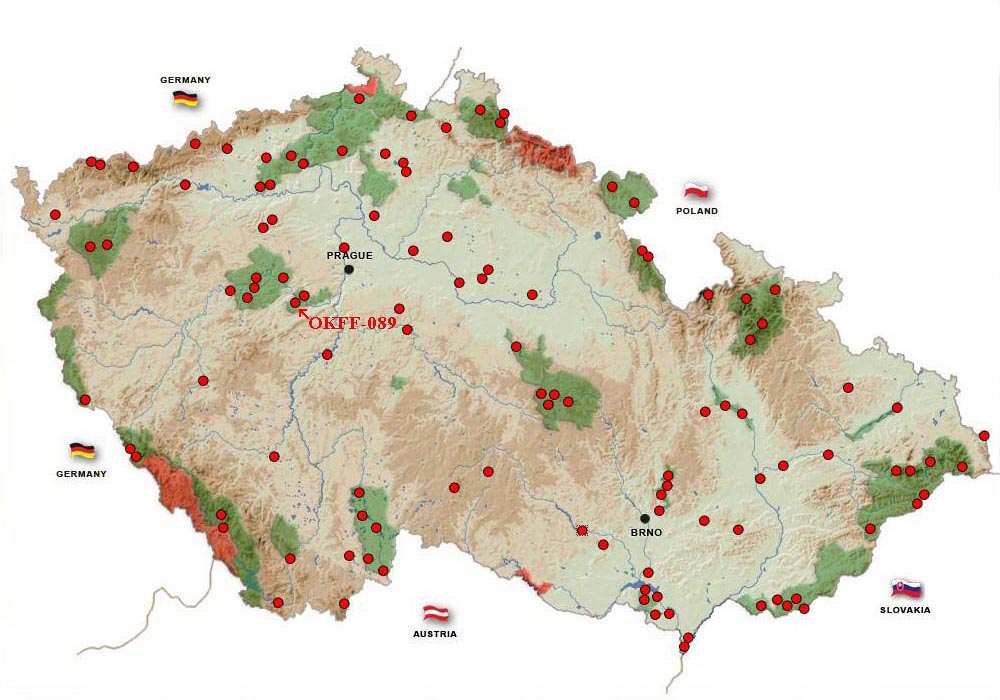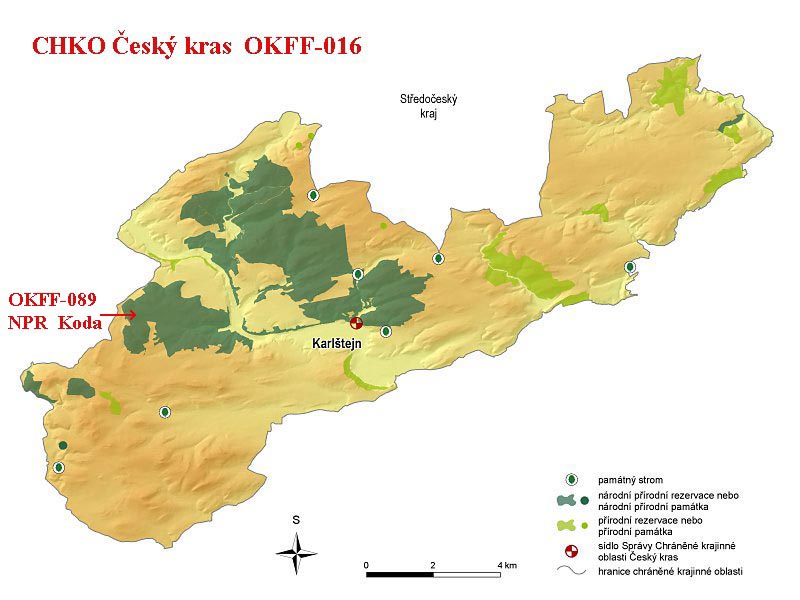Flora & Fauna - Czech Republic
NNR Koda - OKFF-089
Basic data:
Designation: 1952,
Area: 463,64 ha,
Height above sea level: 220–467 m
The Koda NNR was declared in 1952 on a territory of 463.64 ha and is among the oldest protected areas in the
Český kras (Bohemian karst) PLA. This is rugged and predominantly forested area to the south and west of the
Berounka river between the villages of Tetín, Tobolka and Srbsko, in the Středočeský kraj – Central Bohemian
Region. The territory is part of the proposed Karlštejn – Koda Site of Community Importance under the Natura
2000 system. The geological basement is formed of Devonian sediments (predominantly limestone).
The subject of the protection is the complex of calciphilous ecosystems which include all of the main biotopes
of the Bohemian karst region. Small areas of alluvial forest are represented in the stream valleys, the steep
shaded slopes are covered with talus and ravine forest accompanied by the poisonous wolfsbane (Aconitum
lycoctonum). At higher elevations and on more gentle slopes there are oak-hornbeam stands with a rich herb
layer flowering in the spring, including hepatica (Hepatica nobilis). Certain sections of the territory are
covered with calciphilous beechwoods with the occurrence of red helleborine (Cephalanthera rubra) and beech
(Fagus sylvatica) which is capable of natural rejuvenation. The shallow, sun-heated soils on south and
south-west facing slopes are typically covered with thermophilous oak communities with sessile oak (Quercus
petraea) and white or pubescent oak (Quercus pubescens), Cornelian cherry (Cornus mas) and the endemic karst
variety of rowan (Sorbus eximia). The herb layer is characterised by purple gromwell (Lithospermum
purpurocaeruleum), burning bush (Dictamnus albus) and lady orchid (Orchis purpurea). These oak stands gradually
merge into xerophilous and thermophilous grasslands and rocky steppe, which represent the primary forest-free
ecosystems in the reserve. Dominant grasses here are the fescue Festuca valesiaca and the feather-grass Stipa
joannis and the broad-leaved herbs which are typical for Český kras include the meadow-rue Thalictrum foetidum,
hoary rock-rose (Helianthemum canum) and golden alyssum (Aurinia saxatilis). The Austrian dragonhead
(Dracocephalum austriacum), which is rare throughout Europe can also be found here. A wide diversity of
calciphilous moss species (e.g. Pleurochaete squarrosa and Porella arboris-vitae) grow here. Notable fungus
species include Biscogniauxia simplicior of the Xylariaiceae, Amanita beckeri and the Bolete Hymenogaster
verrucosus.
Koda NNR is rich in thermophilous invertebrate species including the gastropods Pyramidula rupestris and
Chondrina avenacea. Thermophilous spiders are the ladybird spider Eresus cinnaberinus and the purse-web
spider Atypus piceus and insect species include the owlfly Libelloides macaronius, the leafhopper Ledra
aurita, the dor beetle Sisyphus schaefferi and many more. The gastropod Bulgarica nitidosa is an endemic
species of the lower Berounka river valley. The fire salamander (Salamandra salamandra) lives in the Císařská
rokle ravine and in the valley of the Koda stream while the great crested newt (Triturus cristatus) lives
around the Tobolský vrch hill.
Endangered bird species in the Koda NNR forests include the stock dove (Columba oenas) with its only permanent
population group on the territory of Český kras PLA as well as the black kite (Milvus migrans). Smooth snakes
(Coronella austriaca) can sometimes be seen on the rocky steppe. A nesting colony of jackdaws (Corvus monedula)
is at home in the abandoned Tomáškův lom quarry and eagle owl (Bubo bubo) also lives here. The wallcreeper
(Tichodroma muraria) occasionally overwinters in the quarry too. Notable cascades of Quaternary freshwater
sediments – tuffa – have formed below the spring resurgences in the Císařská rokle and Kodská rokle ravines.
Nearly 50 caves and karst cavities have been documented on the territory of Koda NNR and some of them have
given us evidence of human usage back to the Pleistocene (Old Stone Age).
We recommend that you set out from the Srbsko railway station and follow the Kodský potok upstream on the
yellow marked tourist trail. From the Koda pond you can choose to stay on the yellow path and continue in
the direction of the Koněprusy caves, which are open to the public, or take the blue trail towards Tetín village.

Map NP, PLA and NPR in the Czech Republic.

Map NNR Koda in PLA Bohemian karst OKFF-016.
Source: http://www.cittadella.cz .
|
|
|